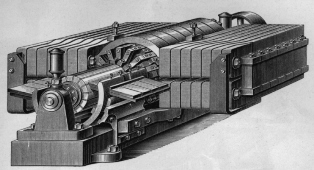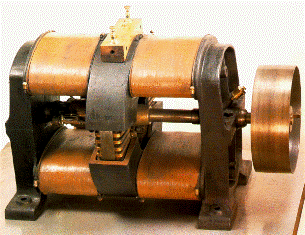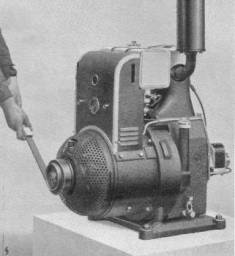Development of DC power plants
The initial period of electrification is connected with the use of direct current. After successful experiments with the use of dynamos in the 70s of the XIX century. There were small generating sets for supplying one particular load: an arc lamp, an electric motor, or a galvanic bath. This was the stage of decentralized production of electrical energy.
The next step in the development of power supply was the power supply from the general generator of a number of receivers - from house power plants; Then there were local stations that served to supply power to the urban block or plant - the so-called block stations. They produced low-voltage current (about 100 - 200 V), which sharply limited the length of electrical networks.
The first block stations appeared in Paris for the supply of Yablochkov candles. In Russia, the first station of this kind was an installation for lighting the Foundry Bridge in St. Petersburg, built in 1879 with the participation. P. N. Yablochkov. At the end of 1881, block stations appeared, in the network of which arc lamps and incandescent lamps were switched on, for example the station in Chesterfield (England) and the station in the Lubyanka passage in Moscow.
Along with the increase in the number of electricity consumers, the capacity of power plants increased and the trend towards centralization of power supply became more and more evident.

The first central electric station was built by TA Edison in 1882 at Pearl Stream in New York City to power the lighting load. Its total power exceeded 500 kW. In 1883 there was a central electric station in St. Petersburg to illuminate Nevsky Prospekt.
Operation of the first CES has detected a shortcoming that has not been overcome during the entire time of DC application: the limited power supply radius, determined by the allowable voltage loss in the electric network. This circumstance made it necessary to build power plants near consumers, mainly in the central parts of the city, which, in turn, made it difficult to supply water and fuel and was associated with a high cost of land. Therefore, in New York at that time were forced to resort to multi-story station equipment, and in St. Petersburg the first power plants were installed on barges on the Moika and Fontanka rivers.
With the growth of electricity consumers, persistent search for ways to increase the distance of energy transfer begins. The three-wire networks proved to be effective according to the scheme proposed in 1882 by D. Hopkinson and independently of him by TA Edison. This method provided an increase in the voltage in the line by half and found a very wide distribution.
Even more effective was the five-wire network, since the voltage increased fourfold. The author of the scheme was V.Siemens. It did not find wide acceptance, since with the increase in the electric power supply radius of only up to 1,5 thousand meters the device of the network became much more complicated.
Another way to increase the transmission range was to build battery substations. The capacity of DC power plants rarely exceeded 500 kW, but a large number of them, built in the last two decades of the nineteenth century, determined their significant share in total power generation.
By the 1990s, the centralized electricity supply became decisive for electric lighting, but did not extend to power electrical equipment. The electrification of working machines in the factory was clearly decentralized: electrified stand-alone large machines and mechanisms for which independent dynamos were installed.

To drive a group of machines through transmissions (large-drive electric drive) instead of a steam engine, relatively large electric motors fed from separate generators were installed. The experience of using electric motors to drive various machine guns gradually convinced them of a greater economy compared to the drive from a steam engine. In the early 1990s, the electrification of power processes began in the mining and metalworking industries, in textile production, and so on.
Large-scale industry put forward by the end of the XIX century. A number of completely new requirements for the conduct of production itself. Its complexity and accuracy increased, the pace of technological processes accelerated, continuous types of production developed, and the areas of industrial enterprises expanded - all this complicated the task of controlling the machine system. In a number of cases, a person was unable to cope with mechanical operations without special additional means. A vivid example of such production was the metallurgical industry.
In the early 90's, the electric drive penetrated the US steel mills for the production of rolled metal and for loading open-hearth and blast furnaces. During this period, automatic control of the processes of start-up, braking, stopping and speed of electric motors with the help of relay-contactor equipment is emerging, as well as schemes of electromechanical automation.
The precursor of electromechanical automation should be considered the invention of Russian electrical engineering VN Chikolev - its differential lamp with an electric motor for regulating the position of coals in an arc lamp (1874). The next step on the way to electromechanical regulation was the generator-engine scheme of M.O. Dolivo-Dobrovolsky (1890) for electric motors with series excitation, which provided approximately constant speed of rotation with significant changes in load.
In 1892 the American engineer V. Leonard proposed a method of smooth and wide regulation of the generator-engine scheme, which became classical. It has found wide application for the electric drive of rolling mills and hoists since 1903, when the German engineer K. Ilgner made an addition to the Leonard scheme in the form of a flywheel to equalize the jolt load. This system of electromachine control is used up to the present time.

Since the 1970s, works on the use of electric power in transport have been under way. In the 80 - 90s of the XIX century. The first electric railways and an electric tram appear. The electric thrust developed mainly on direct current.
Electric motors of direct current as they spread in various industries have acquired the reputation of a universal and trouble-free source of mechanical energy.
The electric drive ensured the simplicity and speed of the start-up, the possibility of regulating the speed of rotation, compactness and lightness, adaptability to any production processes at lower operating costs per unit of output compared with the steam drive. However, the limited possibilities of transmitting electric power over a distance with direct current could not provide wide electrification.
Shukhardin S. "Technology in its historical development"


Comments
When commenting on, remember that the content and tone of your message can hurt the feelings of real people, show respect and tolerance to your interlocutors even if you do not share their opinion, your behavior in the conditions of freedom of expression and anonymity provided by the Internet, changes Not only virtual, but also the real world. All comments are hidden from the index, spam is controlled.